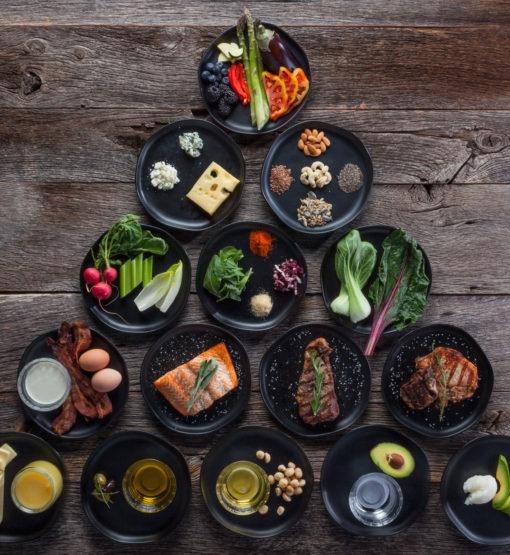Types of Keto Diets Explained: Standard, Cyclical & Targeted

While the basics remain the same (very few carbs), slight modifications help make the low-carb lifestyle work for different people, depending on their goals.
For example, one version of the diet is designed for athletes and allows you to eat more carbs than normal once per week. Another takes into account when you eat your carbs each day, so you can maximize performance.
In this article, we'll explain the three keto diet types, which is best for you depending on your goals, and the potential drawbacks of modifying the diet.
What Is the Ketogenic Diet?
Keto, or the ketogenic diet, is a high-fat, low-carb nutritional approach[*].The macronutrient breakdown of this diet typically looks as follows:
- 70 percent of your daily calories come from fat
- 25 percent of your daily calories come from protein
- 5 percent of your daily calories come from carbs

On a 2,000-calorie diet, this breaks down to 155 grams of fat, 125 grams of protein, and 50 (or fewer) grams of carbs. Your energy requirements will vary depending on your goals.
Keto dieters base their meals around low-carb vegetables, fatty proteins, and healthy fats like avocados, eggs, nuts, and olive oil. Micronutrient and fiber-rich foods are also a priority.
Why? Because restricting your daily carb intake to 5-10% of your caloric intake induces a state called ketosis, where your liver produces natural chemicals called ketones.
These ketones burn stored body-fat instead of glucose (sugar) as your primary energy source, which not only helps you lose weight on a ketogenic diet, but improves health, too.
The Benefits of the Keto Diet
Just twenty years ago, the conventional notion was that eating lots of fat makes you fat (and increases your risk of heart disease)[*].Fast forward to today, and modern science shows there's actually a lot to like about high-fat, low-carb dietary routines like keto.
For example, studies show that a ketogenic diet can[*]:
- Be an incredibly effective tool for weight loss
- Control blood sugar, and possibly reverse type 2 diabetes
- Improve blood lipid profiles
- Potentially prevent against or improve the symptoms of diseases like cancer, Alzheimer's, and epilepsy (the ketogenic diet was originally designed in the 1920s as a tool to treat epilepsy[*])
Also Read: Showdown: Calories vs. Macros for Weight Loss
But as the article title suggests, there are now different types, or at least modifications, of this eating pattern.Why Are There Different Types of the Ketogenic Diet?
If the benefits of a traditional keto diet are well-documented and plentiful, why might you modify the diet?The short answer is that each iteration of the keto diet offers specific benefits. And slight alterations may fit better with a person's lifestyle, and help them achieve their goals faster.
For example, a cyclical ketogenic diet (described below) may be useful for athletes. They're given more freedom to eat carbs from time to time, which can help fuel long-distance runs or allow for particularly intense training sessions.
Still, the basis of the diet remains the same—eating lots of healthy fats, proteins, and fiber-dense foods, and limiting carbs to about 50 per day.
It's important to understand that if the diet doesn't promote ketosis, it's not technically a keto diet.
What Are The Different Keto Diet Types?
That said, there are different iterations of the keto diet. Three popular ones are:- The standard ketogenic diet (SKD)
- The cyclical ketogenic diet (CKD)
- The targeted ketogenic diet (TKD)
The Standard Ketogenic Diet (SKD)
As described above, the standard keto diet is a high-fat, low-carb, moderate-protein diet.Because of its undeniable results—particularly for weight loss—it's one of a handful of diets (Paleo, Atkins) that sparked a popularity increase in low-carb diets.
Here are a few general guidelines that set the standard ketogenic diet apart from the cyclical and targeted keto diets:
- You eat until you're full and don't have to count calories
- You generally eat the same thing each day (actual food items will vary, but the macronutrient split outlined earlier will be the same or similar)
- You likely eat three times per day, although this can vary (there is no set time for meals)
Potential Drawbacks
Your body is used to running off glucose, so there is generally an adjustment period when switching to a keto diet.Many users experience fatigue, dehydration, and other symptoms of the "keto flu," which tend to go away after a week or two.
The Cyclical Ketogenic Diet (CKD)
The cyclical ketogenic diet is a standard keto diet where you purposely deviate by eating clean carbs (between 100 and 150 grams) one or two days per week.This creates a carb "cycle" that you can then use to enhance performance in workouts.
Even though many athletes use the standard ketogenic diet (like our partner Tim Tebow), the CKD is targeted towards athletes or anyone that exercises frequently.
While keto-friendly supplements like exogenous ketones can be used to boost performance in lieu of glucose, your performance, especially during long-duration workouts, may benefit from eating more carbs.
Some studies also show that eating carbs can improve your ability to add new muscle, especially after workouts (though a targeted ketogenic diet could also help—see below) [*].
Potential Drawbacks
The main consideration (and potential drawback) of the CKD is that you won't be in ketosis on the days where you eat more carbs. Clean carbs or not, your body needs to be deprived of muscle glycogen before it will shift over to ketones for fuel.It's equally important to note that if you don't exercise enough, it may take more than just one day to get back into ketosis. You won't automatically re-enter ketosis just because you drop back down to 50 grams of carbs the following day.
Depending on how active you are, it could take two or three days before you get back into ketosis.
So while this approach may fuel performance, if you aren't careful, it won't even technically be a ketogenic diet.
The Targeted Ketogenic Diet (TKD)
The targeted ketogenic diet is a standard keto diet where you take into account nutrient timing.Unlike the CKD, you still eat 5-10% of your daily caloric intake in carbohydrates to help you stay in ketosis.
But as opposed to the standard ketogenic diet, you purposely eat those carbs before and after exercise to help fuel your performance.
Eating carbs before a workout has been shown to improve performance [*]. And eating carbs after a workout (within 45 minutes) in conjunction may boost recovery and improve your fitness gains from the session [*].
Potential Drawbacks
Again, you might have a killer training session if you eat all 50 grams of carbs before a workout. But you might not get into ketosis again right after you exercise, either.Like the CKD, you need to be diligent about staying in ketosis (a ketone home monitoring kit can help).
Another thing to consider about the TKD is that certain foods will be off-limits for most of the day. If you eat all 50 grams of carbs before and after workouts, you likely can't eat fruit, some vegetables, or even higher-carb nuts the rest of the day.
Depending on your level of discipline, this could make sticking to the keto diet difficult. A TKD might improve training, but if it's too hard for you to do consistently, it may not be worth it.
Different Types Of Keto Diets: What To Consider
To summarize, the three most popular keto diet types are the standard, cyclical, and targeted ketogenic diets.Here are the main differences among the diets:
- A standard keto diet prioritizes nutrient-dense foods and eating 30-50 grams of carbs per day to induce ketosis.
- A cyclical keto diet encourages low-carb eating 5 or 6 days a week, with one carb "refeed" day to boost performance during workouts.
- A targeted keto diet is almost the same as a standard keto diet. Day in and day out, you focus on quality nutrients and 50 grams of carbs per day. However, you eat all your carbs before and after exercise to boost performance.
Our advice is to experiment with the diets and see what works best for you. Prioritize ketosis, and we're confident that no matter what your goals are, you'll be happy with the results.
-
Posted in
Authority Article, Beginner, Ketosis, Low-Carb Diets, Nutrition, Starting Keto




